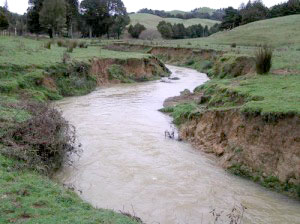 How to Help Prevent Soil Erosion This Spring How to Help Prevent Soil Erosion This Spring
By Scott Gall, West Multnomah SWCD, and Jennifer Nelson, Tualatin SWCD
“A nation that destroys its soil destroys itself.” Franklin Roosevelt wrote that in a 1937 letter calling for the creation of local Soil & Water Conservation Districts like the Tualatin SWCD and the West Multnomah SWCD as part of the national response to the devastation caused by the Dust Bowl. Eighty years later, we’ve come a long way in our understanding of the strength and fragility of native soils, yet erosion remains a constant concern.
Soil erosion is the detachment and movement of soil particles by water and wind, gravity and even ice. Since it may take 200 years to form one inch of soil, erosion occurring on your land is usually a bad thing. While soil erosion is of most concern on farms, steep hillsides or along a stream, erosion around a house can compromise foundations, clog drains, and undermine garden plants. In most instances, soil erosion occurs when the surface is not adequately covered, allowing wind, rain, and flowing water to dislodge the soil and carry it away.
Plant for Protection, Productivity
One of the best ways to stabilize soil and slopes is by planting grass, shrubs and trees. Their root systems ,and the fibrous fungus (mycorrhiza) that attach to them, literally hold the soil in place. The roots can also create holes, known as pores, which allow water to seep into the ground so that it doesn’t pool on the surface and wash soil away. Plants also pull water out of the soil, preventing it from getting too saturated and heavy in steep areas.
The roots of plants also pump organic matter deep into the soil. Organic matter, formed from the breakdown of living material, is literally the glue that holds soil together. Organic matter also helps water to reach deep into the soil while providing nutrients for crops, trees and even ornamental plants in the garden. While mulches, composts and other organic amendments can add organic matter, plants are the most efficient way to get it deep into the soil and help prevent soil erosion.
This spring, you have two opportunities to learn how to prevent soil erosion and protect soil health:
Soil School: April 5, Registration required!
Join your local conservation experts and nationally recognized soil health experts to learn more about soil health; separate tracks offered for beginning gardeners, more experienced gardeners, and small farms.
Streambank Erosion Control Workshop: April 16
Understand how and why erosion occurs, what the options for engineered solutions are, and how streamside restoration can help. Check back at our website later this month for workshop location, times, and registration!
Details at: swcd.net/event/streambank-erosion-control-workshop/
We’re here to help! You can also contact your local Soil and Water Conservation District for more information: Tualatin SWCD (Washington County) 503-648-3174; West Multnomah SWCD 503-238-4775. |
